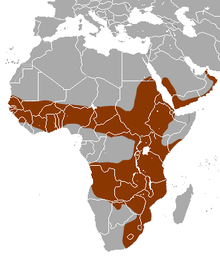White-tailed mongoose
| White-tailed mongoose | |
|---|---|

| |
| Scientific classification | |
| Domain: | Eukaryota |
| Kingdom: | Animalia |
| Phylum: | Chordata |
| Class: | Mammalia |
| Order: | Carnivora |
| Suborder: | Feliformia |
| Family: | Herpestidae |
| Genus: | Ichneumia I. Geoffroy Saint-Hilaire, 1837 |
| Species: | I. albicauda[1]
|
| Binomial name | |
| Ichneumia albicauda[1] (G. Cuvier, 1829)
| |
| Subspecies | |
| |

| |
range of the white-tailed mongoose
| |
The white-tailed mongoose (Ichneumia albicauda) is a species in the
Taxonomy
Herpestes albicaudus was the
Characteristics
The white-tailed mongoose attains a weight range of 1.8 to 5.2 kg (4.0 to 11.5 lb), with an average of approximately 3.38 kg (7.5 lb), has a head-and-body length of 53 to 71 cm (21 to 28 in) and a tail length of 40 to 47 cm (16 to 19 in).
Distribution and habitat
The white-tailed mongoose lives in most of Africa south of the Sahara, and the southern portion of the Arabian Peninsula.[2] It lives in a wide range of habitats, from semi-desert to savanna woodland, but avoid moist areas like the Congo River basin or extremely arid areas. It prefers areas of thick cover, such as the edges of forests and brushy streams.[11]
In the
Behaviour and ecology
The white-tailed mongoose is primarily
These mongooses are very vocal, and make an unusual barking sound that is associated with sexual behavior. If frightened, they will secrete a noxious substance from their anal glands. They do not stand on their hind feet for any length of time like other mongooses.[11]
Diet
The white-tailed mongoose feeds mostly on
Reproduction
Knowledge of the reproduction of the white tailed mongoose is incomplete. Litters are seen most frequently from February to May, and no young appear at all during the dry season from August to November, which suggests that they only breed once a year. The young are fully weaned at nine months of age, and around this time, the young disperse. It is speculated that sexual maturity is reached before two years of age, and that the gestation period is around 60 days.[11]
Etymology
The genus name, Ichneumia, is derived from the Greek ichneumon, which means 'tracker'. This name also happens to be the species and common name for the Egyptian mongoose (Herpestes ichneumon). The species name, albicauda, is derived from the Latin words albus, meaning 'white', and cauda, which means 'tail'.[11]
Local and indigenous names
In Tigrinya language, it is called ፂሒራ (tsihira).[13]
References
- OCLC 62265494.
- ^ . Retrieved 19 November 2021.
- OCLC 62265494.
- ^ Cuvier, G. (1829). "Les Mangoustes. Cuv. (Herpestes, Illiger)". Le règne animal distribué d'après son organisation, pour servir de base à l'histoire naturelle des animaux et d'introduction à l'anatomie comparée. Paris: Chez Déterville. pp. 157–158.
- ^ Geoffroy Saint-Hilaire, I. (1837). "Notices sur deux nouveaux genres de Mammifères carnassiers, les Ichneumies, du continent Africain, et les Galidies de Madagascar". Annales des Sciences Naturelles. 2. 8: 249–252.
- ^ ISBN 1890132446.
- ^ S2CID 29215469.
- ^ .
- ^ a b Egi, N. (2001). Body mass estimates in extinct mammals from limb bone dimensions: the case of North American hyaenodontids. Palaeontology, 44(3), 497-528.
- ^ .
- ^ a b c d e f g Dewey, T. and N. Greene. 1999. Ichneumia albicauda at Animal Diversity Web. Accessed June 14, 2010.
- ^ Bauer, H., Mohammed, A. A.; El Faki, A.; Hiwytalla, K. O.; Bedin, E.; Rskay, G.; Sitotaw, E.; Sillero-Zubiri, C. (2018). "Antelopes of the Dinder-Alatash transboundary Protected Area, Sudan and Ethiopia" (PDF). Gnusletter. 35 (1): 26–30. Archived from the original (PDF) on 2021-01-29. Retrieved 2018-12-03.
{{cite journal}}: CS1 maint: multiple names: authors list (link) - ^ ISBN 9783030049546.

